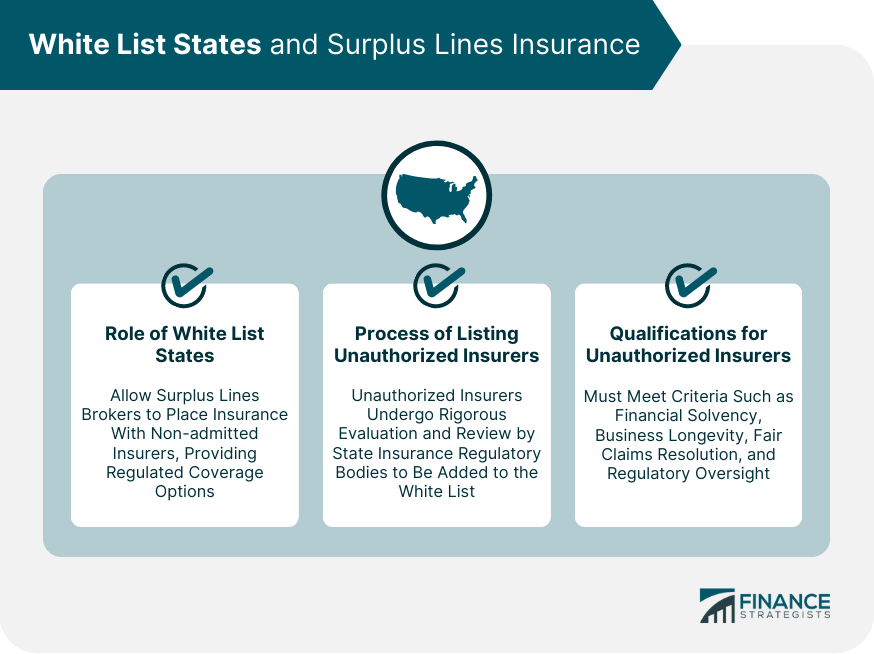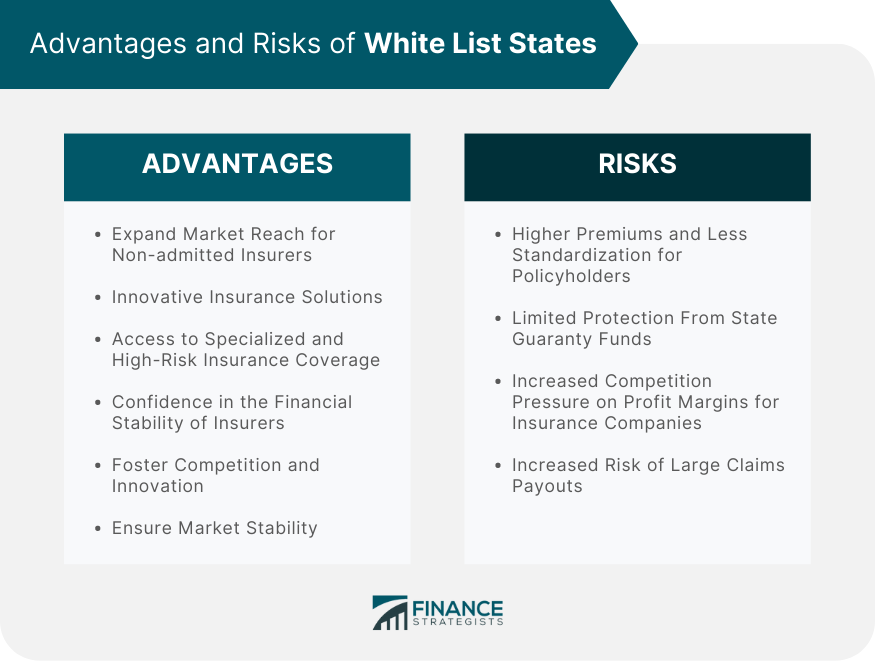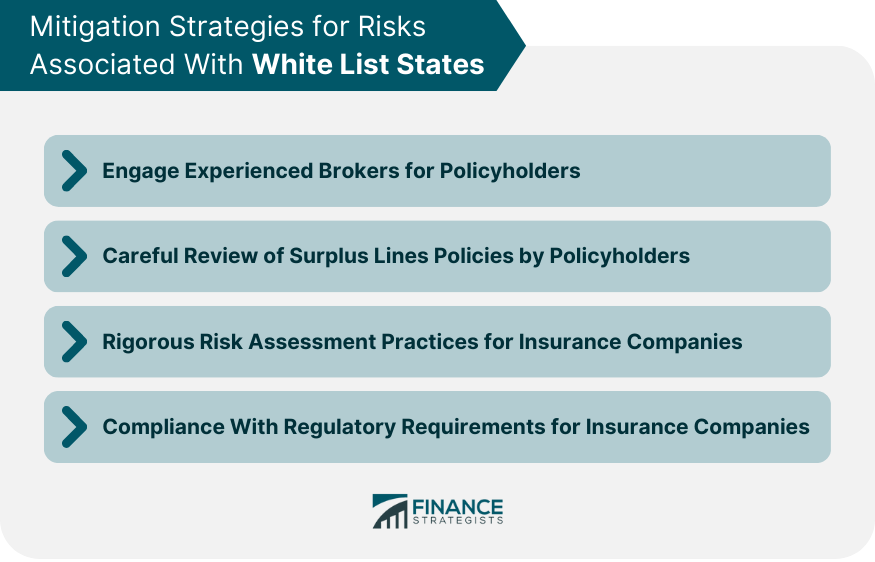White list states in the US insurance industry maintain an approved list of non-admitted insurance companies, also known as unauthorized insurers. These insurers provide surplus lines insurance, a specialized type of coverage. The purpose of white list states is to make high-risk insurance accessible when traditional insurers cannot provide it. By maintaining white lists, these states ensure that only reputable and financially stable non-admitted insurers can offer surplus lines insurance. Surplus lines insurance protects against high-risk or unusual situations that regular insurers avoid. It allows businesses and individuals to manage unique risks and is customizable because it is not subject to state restrictions on rates and forms. White list states play an essential role in the surplus lines insurance market. In these states, surplus line brokers can place insurance with non-admitted insurers from the white list without obtaining the usual diligent search requirement of the admitted market. By doing this, white list states provide a regulated avenue for coverage from non-admitted insurers. The process of listing unauthorized insurers in white list states involves stringent evaluation and review by the state's insurance regulatory body. These insurers must prove their financial stability, reputation, and adherence to specific regulatory standards. This vetting process often includes analysis of audited financial statements, business history, corporate structure, and more. Once vetted and approved, these insurers are added to the white list and can offer surplus lines insurance. Unauthorized insurers must meet several qualifications to be listed in white list states. These typically include demonstrating financial solvency, business longevity, and a history of fair claims resolution. Additionally, they must provide proof of the home state or country's regulatory oversight, ensuring that the insurer is authorized and regulated in its domicile. Despite non-admitted insurers not being subject to all the same state regulations as admitted insurers, they are not without regulatory oversight in white list states. These states scrutinize the insurers' financial health, business conduct, and claims-handling practices before adding them to the white list. Furthermore, they continue to monitor these insurers to ensure ongoing compliance with financial and ethical standards. In white list states, surplus lines insurance is governed by distinct regulations. These rules generally focus on the qualifications of surplus line brokers, reporting requirements, and tax obligations. Notably, while surplus line insurers are exempt from many state regulations that dictate policy terms and rates, they are still subject to state laws regarding unfair trade practices and deceptive acts. Unauthorized insurers listed in white list states must maintain compliance with state-established criteria to remain on the white list. This compliance typically entails submitting periodic financial disclosures, maintaining satisfactory business conduct, and responding appropriately to policyholder claims. Failure to comply with these requirements can result in removal from the white list and consequent loss of business in the state. One of the most significant advantages that white list states provide for insurance companies, particularly non-admitted insurers, is the ability to broaden their market reach. Typically, insurance companies need to be licensed in each state they operate, but this system allows non-admitted insurers to circumvent that process, providing them with the opportunity to extend their operations and increase revenue. White list states allow for more flexible regulation, creating an environment that encourages innovative, custom-tailored insurance solutions. This flexibility in policy design and pricing allows insurers to better meet their clients' unique insurance needs, providing coverage that might not be available in the traditional insurance market. For policyholders, the primary advantage of white list states is the availability of specialized and high-risk insurance coverage. Regular insurers often refuse to cover unusual or high-risk entities due to the increased likelihood of claims. However, in white list states policyholders can access this coverage from non-admitted insurers. The vetting process implemented by white list states gives policyholders confidence in their chosen insurance provider. Despite being non-admitted, these insurers are thoroughly assessed for financial stability and reputability before being added to the white list. As such, policyholders can trust that these insurers are reliable and trustworthy. The existence of white list states has wider implications for the entire insurance industry, fostering competition and promoting innovation. With more players in the market, insurance companies are encouraged to develop new solutions and strategies to meet evolving insurance needs and stand out from their competitors. White list states play a significant role in maintaining the stability of the insurance market. By allowing non-admitted insurers to provide surplus lines insurance, they help ensure that high-risk entities can still obtain coverage. This spreads the risk more broadly across different insurers, which can reduce the impact of large claims on the industry as a whole. White list states and surplus lines insurance can bring potential risks for policyholders. Due to the higher-risk nature of surplus lines insurance, policyholders may face elevated premiums. Moreover, given the less regulated nature of the surplus lines market, there's less standardization in policy terms and coverage, which may make policies more challenging to understand and compare. Another significant consideration for policyholders in white list states is the potential lack of protection should a surplus lines insurer become insolvent. While state guaranty funds typically cover claims if an admitted insurer fails, they generally do not extend this protection to policyholders of non-admitted insurers. This leaves policyholders with limited recourse in the event of their insurer's insolvency. While the surplus lines market provides opportunities for non-admitted insurance companies to expand their operations, it also carries inherent risks. The flexibility of rate setting, which is one of the key characteristics of this market, can lead to fierce competition. This heightened competition can put significant pressure on profit margins, especially in a market scenario where several insurers are chasing the same high-risk policies. In addition to the competitive pressure, insurance companies operating in the surplus lines market also face the risk of larger claims payouts. By nature, surplus lines insurers take on higher-risk policies that traditional insurers are unwilling to cover. While these policies often come with higher premiums, reflecting the increased risk, they also have the potential for large claims payouts if the insured risk event occurs. This can pose significant financial challenges for the insurance companies if not adequately managed. Policyholders can mitigate risks by working with experienced brokers well-versed in the surplus lines market. These professionals understand the complexities of this market and can guide policyholders through the process, ensuring they secure the most appropriate coverage for their unique needs. Another key mitigation strategy for policyholders is to carefully review and fully understand the terms of their surplus lines policies. Given the less standardized nature of these policies, they can vary significantly from traditional insurance policies. Understanding the coverage limitations, exclusions, and the insurer's claims handling process can prevent unwelcome surprises in the event of a claim. For insurance companies operating in the surplus lines market, maintaining rigorous risk assessment practices is critical. These practices involve thorough underwriting and careful consideration of the unique risks associated with each policy. This careful risk assessment allows insurance companies to set appropriate premiums that reflect the higher-risk nature of the policies they underwrite. Lastly, insurance companies must ensure full compliance with all regulatory requirements of white list states. Regulatory bodies closely monitor these insurers to ensure their financial stability and ethical business practices. Non-compliance can lead to removal from the white list, which can significantly disrupt business operations. Therefore, adhering to these regulations is crucial for maintaining a stable presence in the surplus lines market. The White List States represent a unique aspect of the insurance market that allows non-admitted insurers to provide surplus lines insurance to cover high-risk entities. The mechanics of this process involve a rigorous vetting and monitoring system to ensure the insurers' stability and reliability. The advantages of this system extend to the insurers, policyholders, and the broader insurance industry, fostering innovation and competition and ensuring coverage for high-risk entities. However, this system also brings potential risks, such as elevated premiums, less standardized policies, and the potential for large claims payouts. Mitigation strategies, such as working with experienced brokers, careful review of policies, rigorous risk assessments, and compliance with regulatory requirements, can help manage these risks. If you are considering surplus lines insurance, it is crucial to consult with a knowledgeable insurance broker who can guide you through the process and ensure you make the best decision for your unique situation.What Are White List States?
Mechanics of the White List States and Surplus Lines Insurance
Role of White List States in Surplus Lines Insurance
Process of Listing Unauthorized Insurers
Qualifications for Unauthorized Insurers in White List States

White List States and Surplus Lines Insurance Regulations
Regulatory Oversight in White List States
Surplus Lines Insurance Regulations in White List States
Compliance With Unauthorized Insurers
Advantages of White List States
Expanding Market Reach for Non-admitted Insurers
Innovative Insurance Solutions
Access to Specialized and High-Risk Insurance Coverage
Confidence in the Financial Stability of Insurers
Fostering Competition and Innovation
Ensuring Market Stability
Risks and Considerations of White List States and Surplus Lines Insurance
Higher Premiums and Less Standardization for Policyholders
Limited Protection From State Guaranty Funds
Increased Competition Pressure on Profit Margins for Insurance Companies
Increased Risk of Large Claims Payouts

Mitigation Strategies for Risks Associated With White List States
Engaging Experienced Brokers for Policyholders
Careful Review of Surplus Lines Policies by Policyholders
Rigorous Risk Assessment Practices for Insurance Companies
Compliance With Regulatory Requirements for Insurance Companies

Final Thoughts
White List States FAQs
White List States are those that maintain a list of non-admitted or unauthorized insurance companies that are permitted to provide surplus lines insurance, which covers risks that are too high for traditional insurers.
The White List States offer insurance companies the opportunity to broaden their market reach and provide innovative, tailored insurance solutions, thanks to a more flexible regulatory environment.
Policyholders in the White List States have access to specialized and high-risk insurance coverage that might otherwise be unavailable. Additionally, they can have confidence in the financial stability of their insurance provider, even if they are non-admitted insurers.
Risks associated with White List States and surplus lines insurance include higher premiums, less standardization in policy terms, and a potential lack of protection from state guaranty funds if the insurer becomes insolvent. For insurance companies, the risks include increased competition and the potential for large claims payouts.
Risks can be mitigated by working with experienced brokers, thoroughly understanding the terms of surplus lines policies, maintaining rigorous risk assessment practices, and ensuring compliance with all regulatory requirements of White List States.
True Tamplin is a published author, public speaker, CEO of UpDigital, and founder of Finance Strategists.
True is a Certified Educator in Personal Finance (CEPF®), author of The Handy Financial Ratios Guide, a member of the Society for Advancing Business Editing and Writing, contributes to his financial education site, Finance Strategists, and has spoken to various financial communities such as the CFA Institute, as well as university students like his Alma mater, Biola University, where he received a bachelor of science in business and data analytics.
To learn more about True, visit his personal website or view his author profiles on Amazon, Nasdaq and Forbes.















